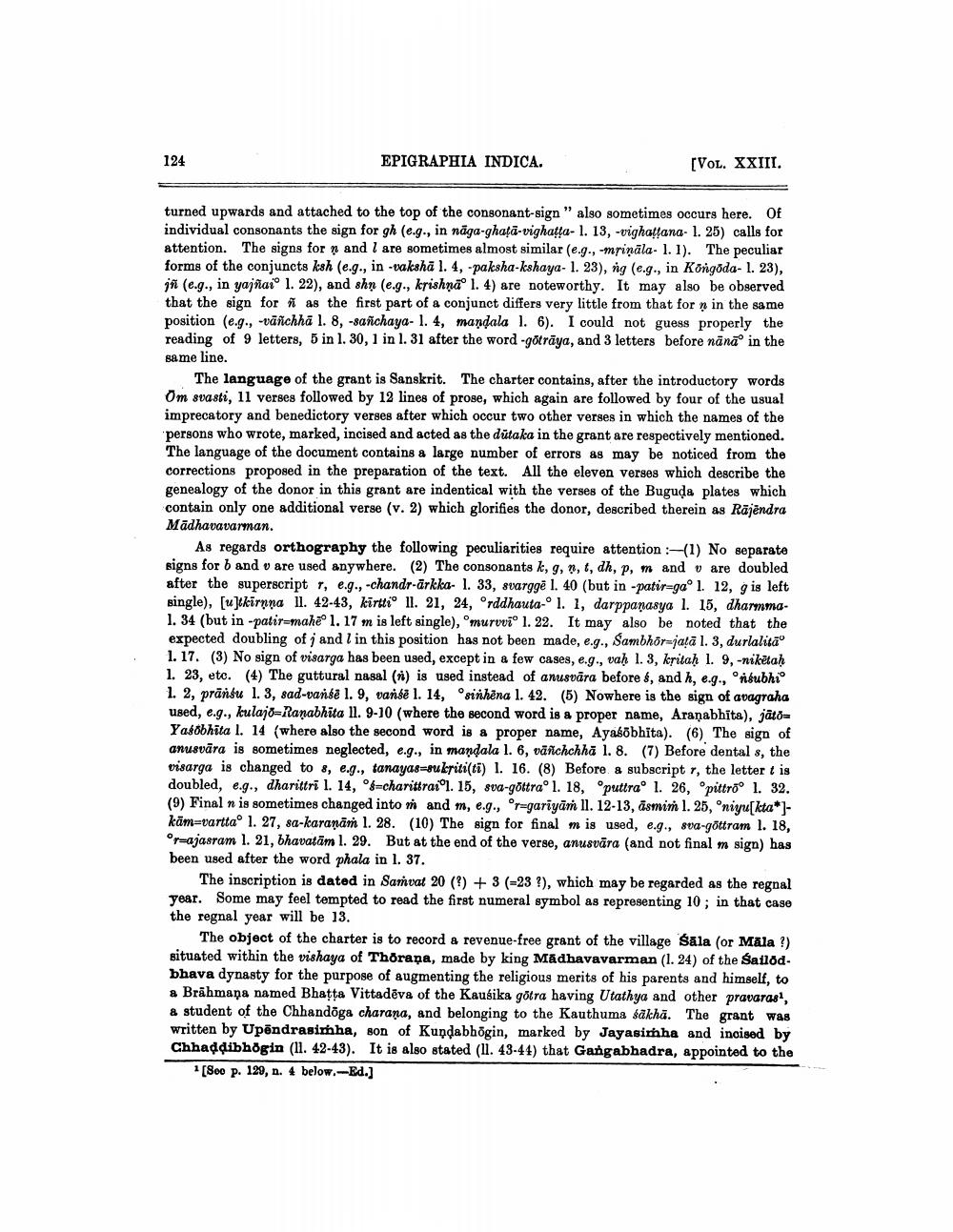________________
124
EPIGRAPHIA INDICA.
[Vol. XXIII.
turned upwards and attached to the top of the consonant-sign" also sometimes occurs here. Of individual consonants the sign for gh (e.g., in nāga-ghatā-vighatta- 1. 13, -vighatana. 1. 25) calls for attention. The signs for ņ and I are sometimes almost similar (e.g., -mrināla. 1.1). The peculiar forms of the conjuncts ksh (e.g., in-vakshā l. 4, -paksha-kshaya- 1. 23), ng (e.g., in Kongoda- 1. 23), jn (e.g., in yajnaio 1. 22), and shn (e.g., krishnão 1. 4) are noteworthy. It may also be observed that the sign for as the first part of a conjunct differs very little from that for n in the same position (e.g., -vāñchhā l. 8, -sanchaya- 1. 4, mandala 1. 6). I could not guess properly the reading of 9 letters, 5 in 1. 30, 1 in l. 31 after the word -gotrāya, and 3 letters before nāna in the same line.
The language of the grant is Sanskrit. The charter contains, after the introductory words Om svasti, 11 verses followed by 12 lines of prose, which again are followed by four of the usual imprecatory and benedictory verses after which occur two other verses in which the names of the persons who wrote, marked, incised and acted as the dutaka in the grant are respectively mentioned. The language of the document contains a large number of errors as may be noticed from the corrections proposed in the preparation of the text. All the eleven verses which describe the genealogy of the donor in this grant are indentical with the verses of the Buguda plates which contain only one additional verse (v. 2) which glorifies the donor, described therein as Rājēndra Madhavavarman.
As regards orthography the following peculiarities require attention :-(1) No separate signs for b and v are used anywhere. (2) The consonants k, g, n, 6, dh, p, m and v are doubled after the superscript 1, e.g., -chandr-arkka- 1. 33, svarggē l. 40 (but in -patir-gao 1. 12, g is left single), [u]lkirnna ll. 42-43, kīrtti 1l. 21, 24, Orddhauta- 1. 1, darppaņasya 1. 15, dharmma1. 34 (but in -patir-maheo 1. 17 m is left single), Omurvvio 1. 22. It may also be noted that the expected doubling of j and l in this position has not been made, e.g., Sambhor jala l. 3, durlalitā° 1. 17. (3) No sign of visarga has been used, except in a few cases, e.g., vaḥ 1. 3, kritaḥ 1. 9, -niketah 1. 23, etc. (4) The guttural nasal (r) is used instead of anusvāra before 8, and h, e.g., nfubhio 1. 2, prānsu 1.3, sad-vansa 1. 9, vansē l. 14, sinhêna 1. 42. (5) Nowhere is the sign of avagraha used, e.g., kulajo=Ranabhita 11. 9-10 (where the second word is a proper name, Aranabhita), jāto= Yasobhita l. 14 (where also the second word is a proper name, Ayasobhita). (6) The sign of anusvāra is sometimes neglected, e.g., in mandala l. 6, vāñchchhā 1. 8. (7) Before dental 8, the visarga is changed to 8, e.g., tanayas=sukriti(ti) 1. 16. (8) Before & subscript r, the letter t is doubled, e.g., dharittri l. 14, °8=charittraiol. 15, sva-göttrao 1. 18, puttrao 1. 26, pittro° 1. 32. (9) Final n is sometimes changed intor and m, e.g., or-gariyāni ll. 12-13, asmin . 25, "niyu[kta*]kām=varttao 1. 27, sa-karanāṁ 1. 28. (10) The sign for final m is used, e.g., sva-göttram 1. 18, Orrajasram l. 21, bhavatām l. 29. But at the end of the verse, anusvāra (and not final m sign) has been used after the word phala in 1. 37.
The inscription is dated in Samvat 20 (?) + 3 (-23 ?), which may be regarded as the regnal year. Some may feel tempted to read the first numeral symbol as representing 10; in that case the regnal year will be 13.
The object of the charter is to record a revenue-free grant of the village Sāla (or Mala?) situated within the vishaya of Thorana, made by king Madhavavarman (1.24) of the Saulod. bhava dynasty for the purpose of augmenting the religious merits of his parents and himself, to a Brāhmaṇa named Bhatta Vittadēva of the Kausika götra having Utathya and other pravaras, & student of the Chhandöga charana, and belonging to the Kauthuma sākhā. The grant was written by Upēndrasimha, son of Kundabhögin, marked by Jayasimha and incised by Chhaddibhögin (11. 42-43). It is also stated (11. 43-44) that Gangabhadra, appointed to the
*[See p. 129, n. 4 below. -Ed.]




